Lukang is well known for its abundance of old temples. Longshan Temple preserves its mid-19th-century style and attractive garden. Then there’s the ever-crowded, ever-noisy Lukang Mazu Temple, famous as a stop along the Dajia Mazu Pilgrimage. Away from the bustling town center is another temple dedicated to Mazu, but unlike any other temple in Taiwan, this one is made almost entirely of glass.
Not only is this temple’s construction materials rather unique, so too is its location. As I cycled out on a YouBike from Lukang’s town center, I thought Google must surely be leading me astray. I was on the man-made island on the west side of Lukang, surrounded by large factory buildings, pedaling down a wide empty road that was clearly designed for large truck traffic. I’d seen temples in town centers and among farms in rural areas, but never in such bleak surroundings as this. After a 20-minute ride, however, the temple came into view next to the much larger Taiwan Glass Gallery, and I parked my bike.
Taking Bus 6936 to the Taiwan Glass Gallery stop is another way to reach the temple. The bus departs from the Taichung HSR nine times a day (12 on weekends) and can also be caught at the Changhua TRA station or in Lukang by the stadium. Having your own scooter or car is certainly the easiest way to get here. However you arrive, this glass-themed area makes for an interesting half-day excursion and is worth the effort if you’re already in the vicinity of Lukang.
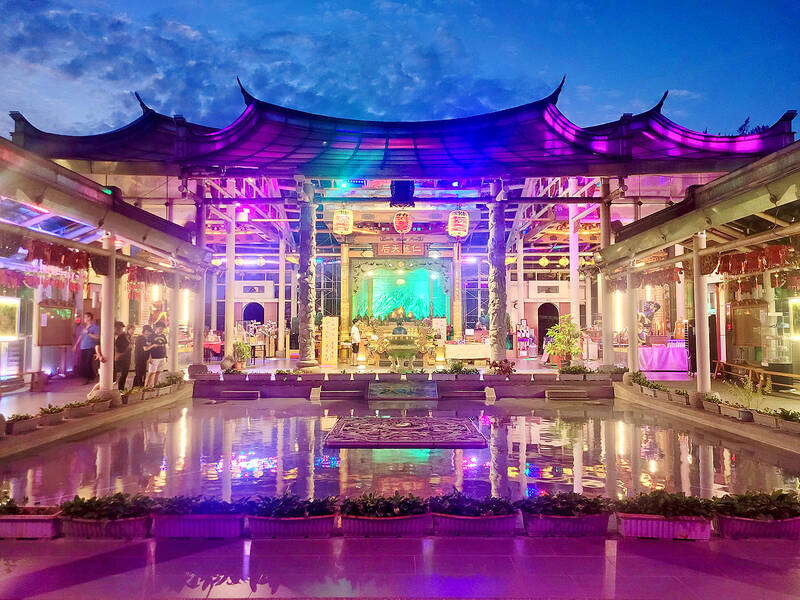
Photo: Tyler Cottenie
THE TAIWAN GLASS GALLERY
As the glass temple is best viewed at night, I made my way over the gravel plaza (even the gravel contains worn pieces of glass) to the Taiwan Glass Gallery (台灣玻璃館) first. There are several distinct shops inside selling decorative blown glass ornaments, as well as ordinary household items made of glass like drinking glasses, coffee pots and vases, sold at ordinary prices. Imagine a cross between an art gallery and an IKEA and you’ll understand what this place feels like; there’s even a cafeteria.
According to the Tourism Administration, local artists are able to display their works here free of charge. There are carefully crafted smaller ornaments mimicking nature, small trinkets to take home as souvenirs, and much larger pieces like a Taipei 101 made of glass and a bridge over a glass river with fish. On the day I visited, I was able to watch an artist in the process of making glass ornaments right in front of one of the displays.
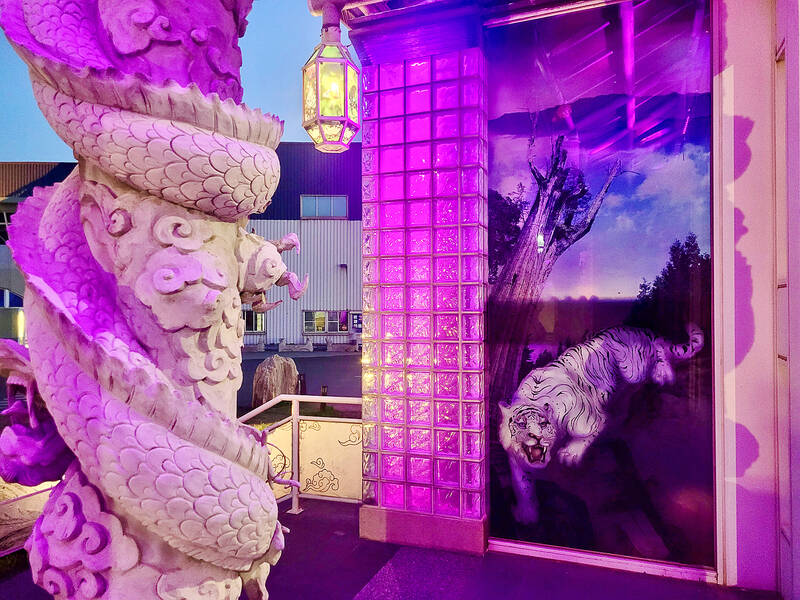
Photo: Tyler Cottenie
If shopping isn’t your thing there are still two other good reasons to come here. In a small building just behind the main gallery building, there is a shop where guests are guided through the process of making their own glass products. This is a time and labor-intensive process so the cost is approximately NT$1,500 per person, but if you’ve always wanted to try real glass-blowing, this is the place to do it. Back inside the main gallery is my favorite part of the visit here: the Golden Tunnel (黃金隧道).
A GLASS MAZE
Entrance to the Golden Tunnel (more like a funhouse hall of mirrors than a tunnel) costs NT$150 and is well worth it. The entrance includes a small gift (two stemless wine glasses) and a pair of locally made white-and-blue flip-flops. The flip-flops must be worn inside the Golden Tunnel, as well as a pair of cotton gloves (provided), in order to protect the glass from scratches and smudges.
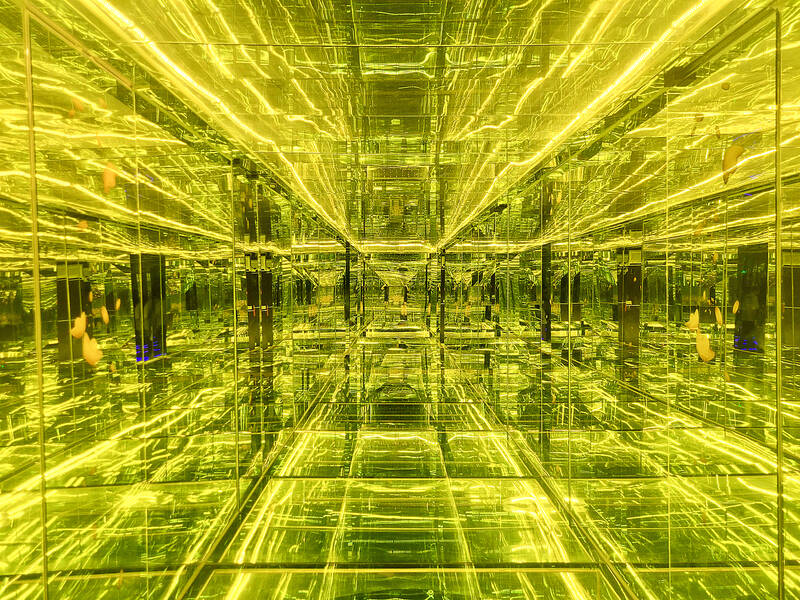
Photo: Tyler Cottenie
Stepping inside, my initial impression was how perfectly clean and transparent all the glass was, so much so that I truly could not tell which way to walk without running into a barrier. Most of the time I had to feel my way along the glass, waiting for a break in the wall. The colorful lighting makes the atmosphere inside rather otherworldly and the way it reflects gives a sense of brightness toward infinity in all directions. As I walked through one long straight section with yellow lighting — from which the attraction must get its name — only my outstretched hand stopped me from running into the end of the seemingly infinite tunnel.
As I rounded another corner, the illusion grew even greater when I noticed an open pit. I could see down to what looked like another two floors below me and my brain wouldn’t let my body move forward here as it seemed I would fall straight down. There was something that could be a transparent floor in front of me, but could also just be a reflection. Only after careful prodding with my foot onto what was actually solid glass but looked like empty space did I dare venture out.
The attraction is not meant to be a maze but it is extremely disorienting being inside and at one point I wasn’t sure if I was retracing my steps or moving through to a new area. As I went back and forth looking (feeling) for the correct way forward, an employee suddenly appeared around the corner. He asked if I was lost and told me that it happens to several people every day. I pointed to where I was planning to go, he nodded his approval, and I carried on, eventually making my way through to the exit.
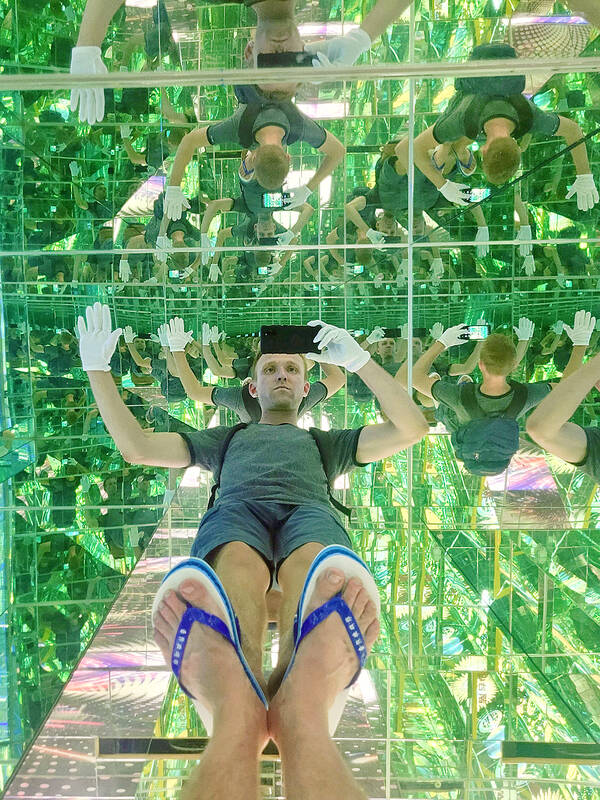
Photo: Tyler Cottenie
The entire attraction occupies very little floor space, but my 15 minutes inside felt like I had covered a vast area. It’s a cheap thrill, it’s well maintained and you get a couple of useful souvenirs out of it, so do check it out if you visit the Glass Gallery.
THE GLASS TEMPLE
If you’ve timed everything right, your visit to the Glass Gallery will finish around sunset. Now is the time to visit the adjacent temple dedicated to Mazu, Taiwan Husheng Temple (台灣護聖宮). It’s quite new, as temples go, having only opened in 2012. Apart from the steel frame, stone floor and wooden ornamentation, the temple is mostly glass. At night, the temple’s lighting shines through the glass walls and roof making the whole structure glow with myriad colors. The shallow pool in the central courtyard reflects these colors, further amplifying the effect.
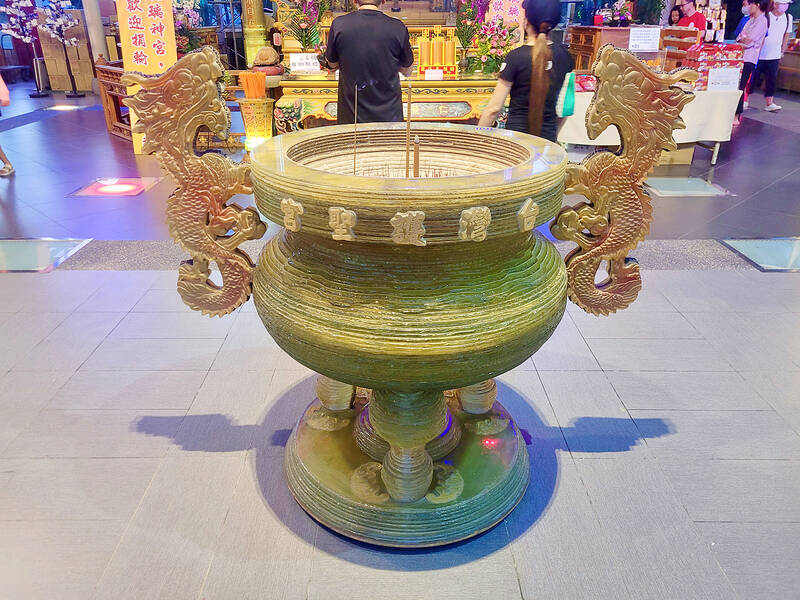
Photo: Tyler Cottenie
Even before entering, the contrast with ordinary temples is apparent. Beautiful glass lanterns with wildlife painted on them hang above the entrance, which features painted deities similar to other temples but on sliding glass doors. The long strip of decorative panels above the door, also common in other temples, is made of glass, making the paintings on them much more prominent. Inside, the altar features a glass mountain scene, glass deities and an incense burner made of glass.
Along the walls is a 12-meter-long painting on glass, inspired by Along the River During Qingming Festival but far eclipsing it in length. Dubbed Wonderful Taiwan in English (台灣豐韻圖), it gives viewers a view of the entire length of Taiwan’s coastline with important locations marked like Sun Moon Lake, the Xiluo Bridge, Hualien’s Qingshui Cliffs and, of course, the glass temple itself. This impressive work took the artist three years to complete but costs nothing to view inside the temple.
Recent renovations to the temple’s lighting system are scheduled for completion this Sunday, so any day after Christmas is a great time to check out this unique sight.
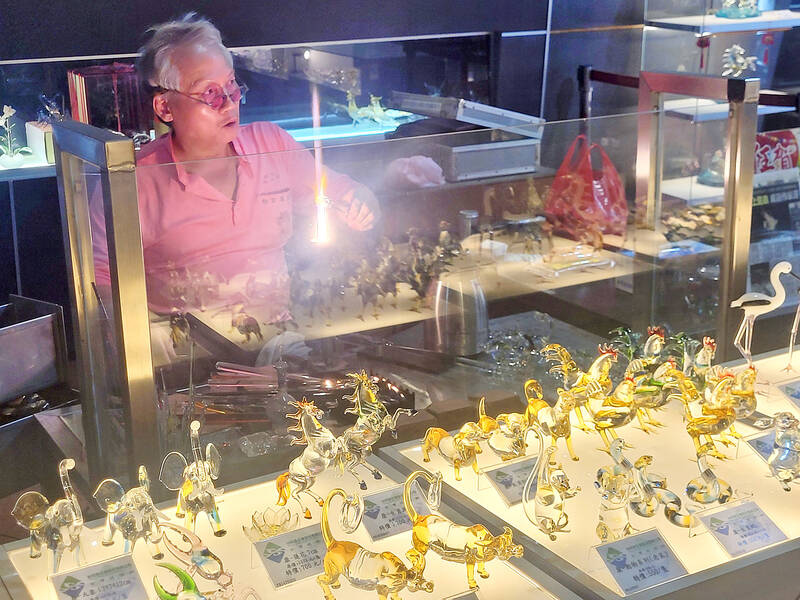
Photo: Tyler Cottenie

Photo: Tyler Cottenie

The Democratic Progressive Party (DPP), Chinese Nationalist Party (KMT), and the country’s other political groups dare not offend religious groups, says Chen Lih-ming (陳立民), founder of the Taiwan Anti-Religion Alliance (台灣反宗教者聯盟). “It’s the same in other democracies, of course, but because political struggles in Taiwan are extraordinarily fierce, you’ll see candidates visiting several temples each day ahead of elections. That adds impetus to religion here,” says the retired college lecturer. In Japan’s most recent election, the Liberal Democratic Party lost many votes because of its ties to the Unification Church (“the Moonies”). Chen contrasts the progress made by anti-religion movements in
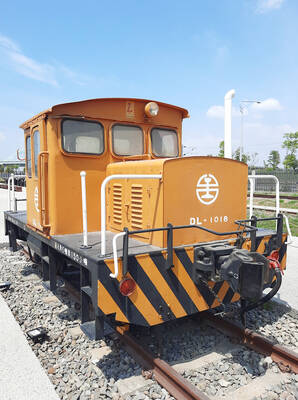
Taiwan doesn’t have a lot of railways, but its network has plenty of history. The government-owned entity that last year became the Taiwan Railway Corp (TRC) has been operating trains since 1891. During the 1895-1945 period of Japanese rule, the colonial government made huge investments in rail infrastructure. The northern port city of Keelung was connected to Kaohsiung in the south. New lines appeared in Pingtung, Yilan and the Hualien-Taitung region. Railway enthusiasts exploring Taiwan will find plenty to amuse themselves. Taipei will soon gain its second rail-themed museum. Elsewhere there’s a number of endearing branch lines and rolling-stock collections, some

Last week the State Department made several small changes to its Web information on Taiwan. First, it removed a statement saying that the US “does not support Taiwan independence.” The current statement now reads: “We oppose any unilateral changes to the status quo from either side. We expect cross-strait differences to be resolved by peaceful means, free from coercion, in a manner acceptable to the people on both sides of the Strait.” In 2022 the administration of Joe Biden also removed that verbiage, but after a month of pressure from the People’s Republic of China (PRC), reinstated it. The American

Chinese Nationalist Party (KMT) legislative caucus convener Fu Kun-chi (傅?萁) and some in the deep blue camp seem determined to ensure many of the recall campaigns against their lawmakers succeed. Widely known as the “King of Hualien,” Fu also appears to have become the king of the KMT. In theory, Legislative Speaker Han Kuo-yu (韓國瑜) outranks him, but Han is supposed to be even-handed in negotiations between party caucuses — the Democratic Progressive Party (DPP) says he is not — and Fu has been outright ignoring Han. Party Chairman Eric Chu (朱立倫) isn’t taking the lead on anything while Fu